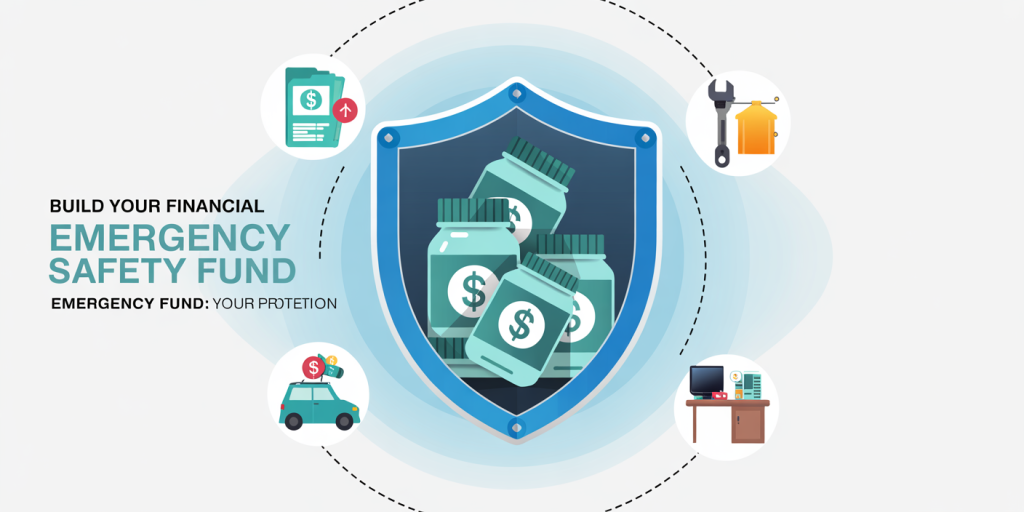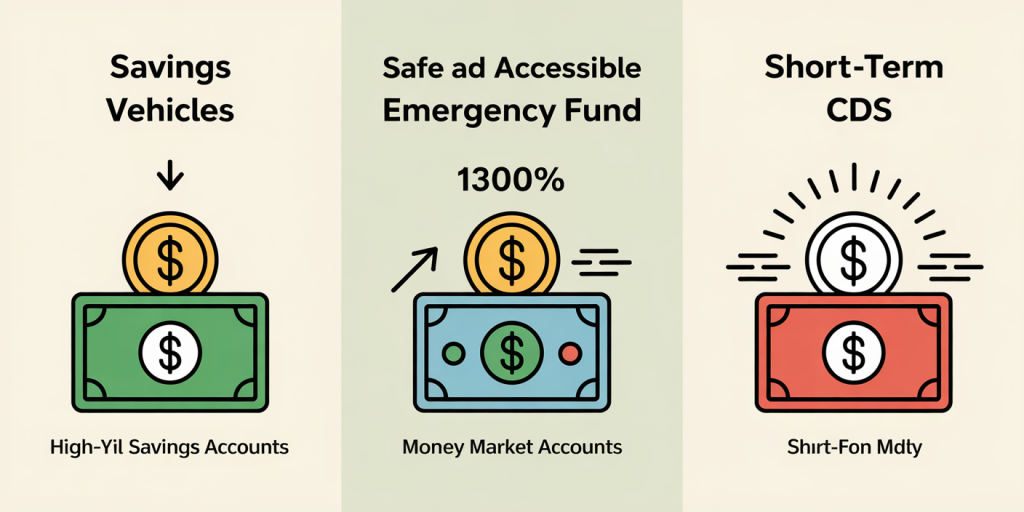Building an Emergency Fund Step by Step
An emergency fund is a financial safety net designed to cover unexpected expenses and provide peace of mind during unforeseen challenges. Whether it’s sudden medical bills, car repairs, or job loss, having readily accessible savings helps individuals avoid debt traps and maintain financial stability. Despite its importance, a surprising number of adults lack sufficient savings for emergencies. According to a 2023 survey by the Federal Reserve, nearly 40% of Americans would struggle to cover a $400 emergency without borrowing or selling something valuable. This alarming figure underscores the need for a deliberate and structured approach to building an emergency fund.

This article will guide readers through the essential steps in constructing an emergency fund, using practical examples and real-world data to emphasize each phase. By understanding the importance of proper planning and incremental savings, anyone can strengthen their financial resilience against uncertainties.
Understanding the Purpose and Size of Your Emergency Fund
Before embarking on the journey to build an emergency fund, it’s crucial to define the fund’s purpose and determine its appropriate size. Emergency funds are not luxury funds; they are lifelines meant for genuine unexpected costs such as medical emergencies, urgent home repairs, or sudden job loss. Differentiating between emergencies and non-emergency expenses protects the fund’s integrity and prevents misuse.
Financial advisors typically recommend that an emergency fund should cover three to six months’ worth of essential living expenses. However, this duration varies depending on individual circumstances like job stability, number of dependents, and personal risk tolerance. For instance, someone with a steady government job might find a three-month cushion sufficient, while a freelancer may target six to nine months due to income variability.
Consider Sarah, a 32-year-old graphic designer. Her monthly essential expenses total $2,500. She opts for a six-month emergency fund, setting a target of $15,000. This clear target guides her savings strategy and provides motivation. Additionally, tracking monthly expenses accurately helps in setting realistic savings goals. Table 1 outlines recommended emergency fund sizes based on employment types and risk factors.
| Employment Stability | Recommended Emergency Fund Size | Example Purpose |
|---|---|---|
| Stable, salaried employee | 3-6 months of essential expenses | Job loss, major repairs |
| Freelancers/Contractors | 6-9 months of essential expenses | Income inconsistency, market downturn |
| Self-employed with variable income | 9-12 months of essential expenses | Business disruptions, unexpected client loss |
This table assists individuals in tailoring their emergency funds to their unique financial landscape.
Establishing a Realistic Savings Plan
Once the size of the emergency fund is set, the next step involves formalizing a savings plan that aligns with one’s income and budget. Starting with analyzing monthly cash flow highlights available surplus after essential expenses and debt obligations. Creating a dedicated savings category for the emergency fund helps prioritize contributions and track progress effectively.
A practical approach involves “paying yourself first,” meaning setting aside a fixed amount or percentage of income as soon as you receive it. This could mean allocating 10-15% of each paycheck toward emergency savings before spending on discretionary items. For example, John, a 28-year-old software engineer earning $4,000 monthly, chooses to funnel $500 into his emergency fund monthly. At this rate, he will reach his $6,000 target in just a year, demonstrating the power of consistent savings.
Automation tools can simplify this process by transferring funds automatically to a separate savings account. According to a 2022 report by the National Endowment for Financial Education, individuals using automated transfers were 25% more likely to meet savings goals than those who did not. Therefore, setting up an automatic transfer reduces the risk of spending savings unintentionally and embeds discipline into financial behavior.
Choosing the Right Savings Vehicle
Selecting the proper account for an emergency fund is paramount to ensure accessibility, safety, and growth potential. The primary purpose of an emergency fund is liquidity; thus, savings should be kept in low-risk, easily accessible accounts. High-yield savings accounts, money market accounts, and short-term certificates of deposit (CDs) are popular options.

High-yield savings accounts offer interest rates significantly above the national average — often around 3% to 4% annual percentage yield (APY), compared to typical savings accounts yielding less than 0.5%. This growth helps the fund keep pace with inflation without sacrificing liquidity. For example, Ally Bank and Marcus by Goldman Sachs provide competitive rates combined with easy online access.
Money market accounts also provide similar interest rates but may come with check-writing privileges, adding to accessibility. However, short-term CDs might offer better interest but lock funds for a set period, which can be disadvantageous in emergencies.
The table below compares popular savings vehicles for emergency funds:
| Account Type | Interest Rate (APY) | Liquidity | Minimum Balance | Ideal Use Case |
|---|---|---|---|---|
| High-Yield Savings Account | 3% – 4% | High – immediate access | None – $500 | Best for emergency funds |
| Money Market Account | 2.5% – 3.5% | High – usually unlimited withdrawals | $1,000 – $2,500 | Slightly better rates with liquidity |
| Short-Term CD (6-12 months) | 4% – 5% | Low – funds locked until maturity | $500 – $1,000 | Suitable if no immediate withdrawal needed |
Opting for high-yield savings or money market accounts balances growth and accessibility, essential qualities for an emergency fund.
Overcoming Common Savings Obstacles
Building an emergency fund poses challenges, particularly for lower-income households or those grappling with existing debt. Unexpected expenses can quickly drain disposable income, while psychological barriers like procrastination hinder consistent saving efforts. Identifying these obstacles and employing effective strategies enable steady progress.
A widespread issue is debt management competing with emergency savings. For example, consider Maria, who earns $3,000 per month with $500 in minimum credit card payments. Allocating money to savings seems impossible when prioritizing debt payments. Financial experts recommend a dual approach: allocate funds first to minimum debt payments while saving incrementally, even if small. Using structured methods like the “Debt Snowball” coupled with saving just $20-$50 per month creates momentum without paralysis.
Additionally, tracking expenses with budgeting apps (e.g., Mint, YNAB) exposes hidden spending leaks. Redirecting discretionary spending, such as dining out or subscription services, into the emergency fund can add meaningful contributions. Cultivating a savings mindset through goal visualization—such as creating vision boards or apps that show progress—motivate individuals to stay on track.

Empirical data from a 2021 Bankrate study emphasizes that 45% of Americans set aside money for emergencies by cutting discretionary spending, reinforcing the practical viability of this method.
Monitoring Progress and Adjusting Strategies
Consistency is critical when building an emergency fund, but so is flexibility and realistic reassessment. Regularly reviewing savings progress helps maintain motivation and correct course when necessary. Tracking tools, including spreadsheets or financial management apps, allow individuals to visualize their journey and set interim milestones.
For instance, David began with a target of $10,000. After six months, he had saved $3,500 but faced additional expenses requiring temporary reduction in contributions. Rather than abandoning the plan, he adjusted the timeline and lowered monthly goals, ultimately reaching success in nine months instead of six. This adaptability is essential to prevent discouragement.
Moreover, inflation and changing lifestyles may require revisiting the fund’s target amount periodically. For example, if essential monthly expenses increase due to housing costs or child-related expenses, recalculating the emergency fund target ensures continued adequacy. The Consumer Price Index (CPI) in the U.S. rose by 5.4% in 2022, potentially increasing cost-of-living and underscoring the importance of fund updates.
A quarterly or biannual review allows an individual to combine savings progress with budget reassessment for maximum efficiency and confidence.
The Future of Emergency Funds: Digital Innovations and Economic Shifts
The landscape of personal finance is continually evolving, and emergency funds are no exception. Technological advancements and changing economic conditions are shaping how people save and access emergency funds.
Digital banking platforms, fintech apps, and AI-driven financial advisors offer unprecedented convenience and personalized recommendations for emergency fund management. Features like round-up savings, where purchase amounts round up to the nearest dollar with the surplus automatically deposited into savings, encourage incremental buildup with minimal effort. For example, the fintech company Chime reported that 30% of its users attributed round-up features to successfully starting their emergency funds.
Additionally, economic uncertainty linked to future recessions, inflation volatility, and climate-related disruptions heighten awareness about the need for robust financial cushions. Experts forecast an increase in emergency fund targets to compensate for longer job search periods and increased healthcare expenses.
Blockchain and decentralized finance (DeFi) may further revolutionize emergency savings by introducing new savings instruments with higher yields and transparent management, although accessibility and safety concerns remain for now.
Ultimately, cultivating the habit of saving and maintaining a fluid, adaptable emergency fund strategy will remain critical, regardless of technological or economic upheavals.
—
Through a structured approach encompassing understanding needs, planning savings, choosing the right accounts, overcoming obstacles, and regularly reviewing progress, building an emergency fund becomes a manageable and rewarding task. Real-world examples, data-driven strategies, and future trends signal that securing financial stability through emergency savings is more crucial than ever—and entirely within reach for those willing to commit.
